The 10 Best Garth Ennis Comics of All Time
Main Art by Tim Bradstreet/ Glenn Fabry/ John McCrea Comics Lists Garth Ennis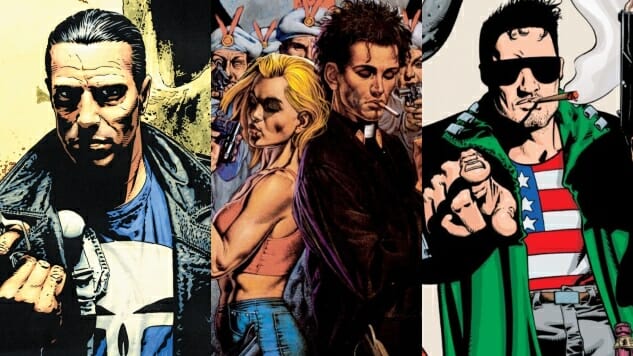
After spending about 10 relativistic decades writing about Alan Moore’s best of, I’m here to give you the deep truth about Garth Ennis’ top 10 books.
Friends, I want you to imagine a man, a man from Northern Ireland. A man who decided every second or third word out of his mouth would be curse word. Garth Ennis is a human pendulum swinging between bawdy tastelessness and righteous outrage.
Ennis’ professional life as a comics writer is, as far as I can tell, based on two obsessions: male friendship and hating superheroes. That’s not the top and toes of Ennis—there’s a lot more ground to cover, as the painter told her subject, but those are the bookends. In reality, Garth Ennis is a studied artist, contrary to how he is presented (and how he’s occasionally presented himself), but most of Ennis’ works are drawn from those two deep wells. Saying an artist has one subject, or two, is not a diminishment. I’ve never seen Ennis and Jane Austen connected in a sentence, but get ready, Lucille, because that’s exactly the direction we’re headed in.
Ennis is concerned with male friendship, in the way that Austen was focused on marriage among rural English gentry. For Ennis and Austen, those paths are their way of talking about literally everything else in the world. In philosophy, there is a famous division of humankind into hedgehogs and foxes. Hedgehogs know one or two big things. Foxes know lots of little things. Ennis and Austen are hedgehogs. In art, however, being a hedgehog works—if the artist is gifted. Wise hedgehogs may speak about anything through speaking about one thing. Austen did, and Ennis does. Using the subject matter of landed matrimony, Austen dissects all human matters. Kind of like how your crank uncle uses any news item to shoehorn in his views about how athletes had hustle back in his day.
Who cuts the middle class to their bones? Who catalogs the inner lives of women? Who has a keener grasp of politics? Austen does. Her obsession is like a highly polished pearl set in the middle of a busy room. There’s one, bright, keenly focused spot. That single point is able to catch everything by way of reflection, like Escher’s drawing of the mirrored balls. In the same way, Ennis has used male friendship and hating superheroes to lecture about politics, drinking, film-making, ethics, killing, the settlement of the West, theology, marriage, toxic masculinity, poetry, Irish revolutionary history and pretty much every topic under the sun. Such as:
![]()
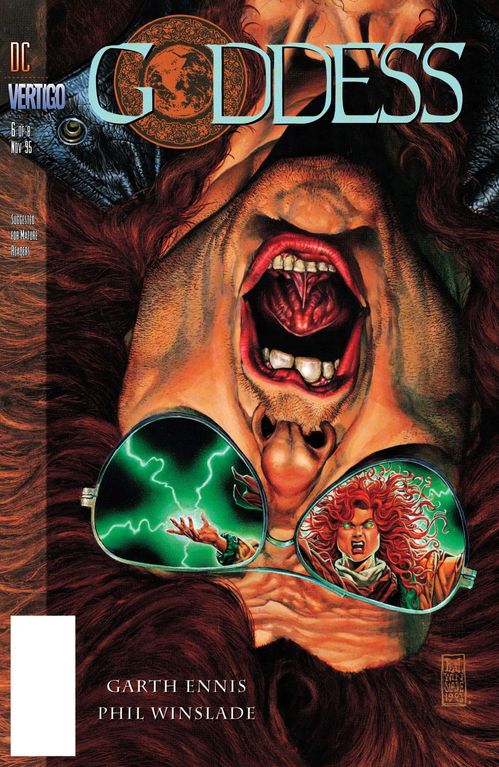
Goddess Cover Art by Phil Winslade
10. Goddess
Artist: Phil Winslade
Publisher: Vertigo/ DC Comics
This is the strangest Ennis, and I put it here to remind me, and my readers, that Garth Ennis is not bound by our preconceptions, any more than George R. R. Martin is bound by human schedules. It’s one of his earliest works, too. Goddess is an eight-issue story about a woman, Rosie Noland, who discovers she’s a deity. There’s not a lot more to it than that. Of course, this is Ennis, so gratuitous abuse of power and flouting of good taste are what follows. Rosie learns about her new skills, and has to make her way through a world of appalling nastiness and gore.
I put Goddess here because it’s Ennis writing a female protagonist. Which brings me to an important point about everyone’s favorite Northern Irish comics writer: there’s a fair amount of early Ennis that rings false and hollow, including an early strain of sexism, reactionism and a certain amount of transphobia and homophobia. He joins genuine empathy with bush-league Reddit contrarianism, and his arguments for atheism would convince a fifteen-year-old—and practically nobody else. He’s uncomfortable writing female protagonists who aren’t action girls. And it shows.
On the other hand, Ennis regularly talks about class and the hollowness of toxic machismo. He addresses injustice and human indignity in a visceral, no-kidding way that most creators don’t. His protagonists face difficult moral choices without easy answers. Above all, when writing characters, Ennis does not cheat. A large part of his canon, even in the problematic years, centers on men who cannot grow up, and suffer for it. Goddess is the first part of Ennis’ long battle against his own worst tendencies as an artist. Despite the deficiencies, it’s still worth reading.
![]()
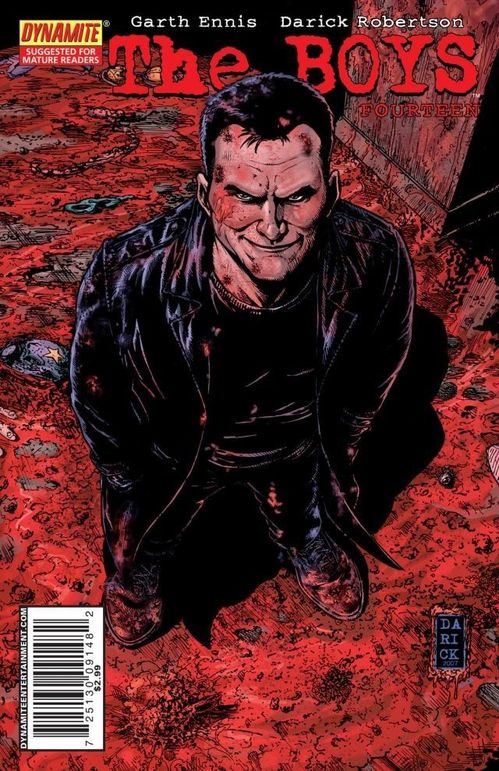
The Boys Cover Art by Darick Robertson
9. The Boys
Artists: Darick Robertson, Russ Bruan, Peter Snejbjerg & John McCrea
Publisher: Dynamite Entertainment
The Boys is the story of a Scottish man named Hughie, who lives in a world of reckless, stupid, celebrity superheroes. He suffers a terrible tragedy, and hooks up with an undercover CIA team of assassins, nicknamed “The Boys.” Led by a grinning psychopath named Butcher, The Boys go around kicking the hell out of anyone with a cape.
The Boys is serious business for a lot of reasons, and it’s got my favorite Ennis villain, Vought-American Vice President James Stillwell. I started reading The Boys and finished the entire series in about three days. It’s propulsive entertainment…even if the gratuitous Ennis-ness makes it kind of a slog. The writing isn’t surprising or innovative. But the scope and ambition of the story are enough to win it a place in the top 10.
What can we make of the series? The Boys is a great work, but not a particularly enjoyable one. It’s Ennis deliberately trying to “do Ennis,” and it shows: there’s a weird mean-spiritedness to the story that, curiously, you don’t often find in the rest of his books. The best parts of The Boys are Robertson’s artwork, Hughie’s parents, the terrifying Homelander and Superduper. Reading The Boys is a bit like reading a book by a really gifted writer who plays for the other political team. He’s misreading everything, but he’s not entirely wrong. What if there was no man in the sky, just a bastard with heat vision?
![]()
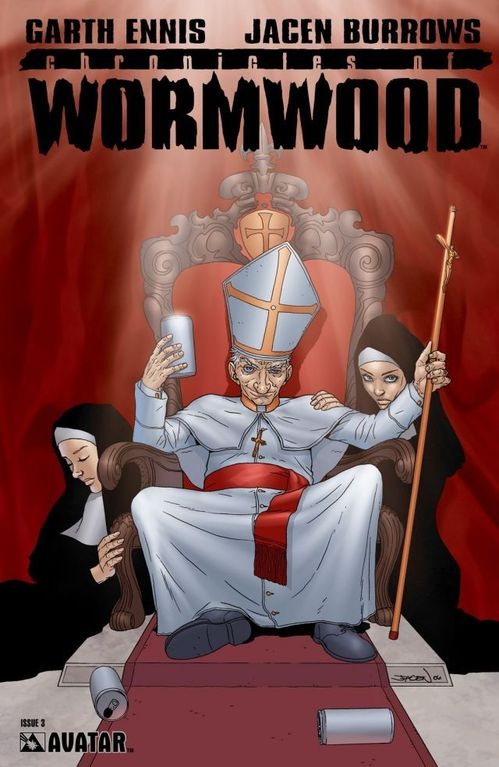
Chronicles of Wormwood Cover Art by Jacen Burrows
8. Chronicles of Wormwood
Artist: Jacen Burrows
Publisher: Avatar Press
“My name is Danny Wormwood, and I’m the Antichrist. How I ended up with a rabbit is beyond me.”
Chronicles of Wormwood concerns the monster at the end of the book, who Ennis makes into a decent dude. Of course the Devil’s firstborn is an Englishman. Also, because this is an Ennis joint, the Beast is friends with a talking rabbit and the brain-damaged incarnation of Jesus. This is a raunchy, tasteless book, like pretty much everything Ennis writes.
That’s not the primary reason for the tale of Wormwood to exist, though. Ennis is writing down his thoughts on politics, religion and morality. If you want to understand how great of a writer Our Man Garth is, consider what a lesser scribe would have made of this setup. A lazy creator would not take the risks Ennis does. This book is also here for another reason: in case it’s not clear by now, Garth Ennis is not a subtle artist. As I’ve said before, he’s careful; that’s not the same thing as subtle.
That’s not an insult—it’s just how the guy rolls. Some anvils need to be dropped, and when Ennis gets around to it, he doesn’t shy away from the message. Wormwood is Ennis going full Heinlein: Here’s what’s wrong with practically everything, and here’s how you fix it. It’s a sign of the man’s unparalleled, ranty skill that it doesn’t tire or weary the reader. It’s also typical of Ennis that his Hell is so much more interesting than his Heaven.
Like most Ennis stories, there’s plenty here that is unsettling, uncomfortable and unfair. But it wouldn’t be Ennis if it didn’t stir you to action, or outrage. Wormwood occupies this space because it’s a categorical example of how Ennis—our godless pastor—is streets ahead of his imitators. If the primary negative emotion in Alan Moore’s works is disappointment, Ennis’ major spring is broad-brush annoyance. This is a story about a man born from the union of a woman and a jackal, which is not surprising…but it’s kind of heartwarming, which is something of a shocker. What can I say? It’s Ennis.
![]()

303 Cover Art by Jacen Burrows
7. 303
Artist: Jacen Burrows
Publisher: Avatar Press
Oh, don’t worry. There’s a fair amount of Paint-It-Black Ennis in this list too. Particularly the next two entries. 303 is the story of a Russian Spetsnaz colonel, a veteran of Afghanistan, the coldest of the cold warriors, and his beloved .303 Lee-Enfield rifle. When the story opens, the Russian is a bygone man with a bygone weapon who has killed in a bygone place. The colonel discovers that 9/11 was a plot, and then goes on a mission to assassinate the president of the United States. That’s the through-line of the book, and it’s more than enough. There’s plenty on the plate besides the targeted killing of an American president who is very much George W. Bush.
Sure, Ennis describes the depravity and folly of war, takes us into a modern slaughterhouse and has words to say over empire and plunder. But here, as always, Ennis wants to tell the stories of men with rifles. He has a fondness for soldiers—especially old, obsessed ones. With all apologies to Punisher fans, this is as close as Ennis will ever get to doing Batman justice, even if he wouldn’t admit it.
![]()

The Punisher Cover Art by Tim Bradstreet
6. The Punisher
Artists: Steve Dillon, Leandro Fernandez, Darick Robertson, Others
Publisher: Marvel Comics
And so, The Punisher. The series Ennis made his own.
There had been about three memorable Punisher runs before he set his mind to work. Some of them quite good, but they might as well have never tried. Ennis swallowed up Frank Castle, gobbled him up whole, and what was left over was all Belfast-imported. I don’t mean to say that the Punishers before Ennis didn’t amount to much. But Punisher before Ennis is like Swamp Thing before Alan Moore. The print of the hand that shapes it is so distinct, it can’t be removed.
The Punisher had always lived uncomfortably with the world of superheroes; he’d been a veteran of a distant war, damaged goods, in search of a justice he could neither make himself nor claim from someone else. Ennis carved out what had always been waiting there. He liberated the nihilism of the character. His Frank hated heroes with a passion. No admiration—just pure contempt. His Frank was still a Vietnam vet, but one who had been chosen by Death’s hand even before his tour overseas. His Frank cared about innocence, but had given up any pretense of doing real justice years ago.
As Ennis himself once pointed out in an interview, Frank Castle is a serial killer in all but name. From Ennis’ first issue, where Castle heaves a criminal off the Empire State Building, to the moment in Born, where the Grim Reaper literally tells Castle what he will be, Ennis is writing darkness visible. I can’t claim this is the writer at his bleakest—Crossed has that honor—but this is a book Ennis was born to write. I would not want that honor. As readers, we are fortunate that Ennis did.
![]()

Enemy Ace Cover Art by James Dietz
5. Enemy Ace: War in Heaven
Artists: Chris Weston & Russ Heath
Publisher: DC Comics
In another universe, where another comic genre reigns supreme, I believe Ennis would have found perfect happiness doing war stories for the rest of his natural existence. It’s where his sympathies lie, where his inclinations take him. Ennis just really, really likes soldiers. In this world of capes, we all are beggared for Ennis tales of Men At War.
Depending on who you ask, Enemy Ace is the grown-up version of 303, or all of Ennis’ war story heroes. Ennis can write a bastard, a degenerate, a fool, a drunk, a cardsharp, a loudmouth and a fraud. Here, Ennis has to write a Good German. Keep in mind the subject is still a World War I ace, which is a nice way of saying he was a serial murderer during the Great War. How does a man like that square with flying for the Nazis?
With difficulty, it turns out. Enemy Ace is another Ennis borrowing. The protagonist, Hans van Hammer, was a Silver Age creation by artist Joe Kubert and writer Robert Kanigher. Ostensibly, the original Enemy Ace stories are about knights of the blue expanse. But the original tales are tinged with melancholy and war-horrors. Sudden death, loss of friends, split-second massacres, the trauma of war. In the ‘60s Enemy Ace, Von Hammer wins, but his war never really ends.
In the Ennis story, Von Hammer is brought out of his castle by an old war buddy, and flies for the Luftwaffe on the Eastern front. He discovers what the Reich is, and does what is required of a hero. The tale is shorn of most of Ennis’ usual affectations; the comedy and irreverence are muted. It’s a clean, tailored, precise piece of work, and a surprising achievement.
![]()
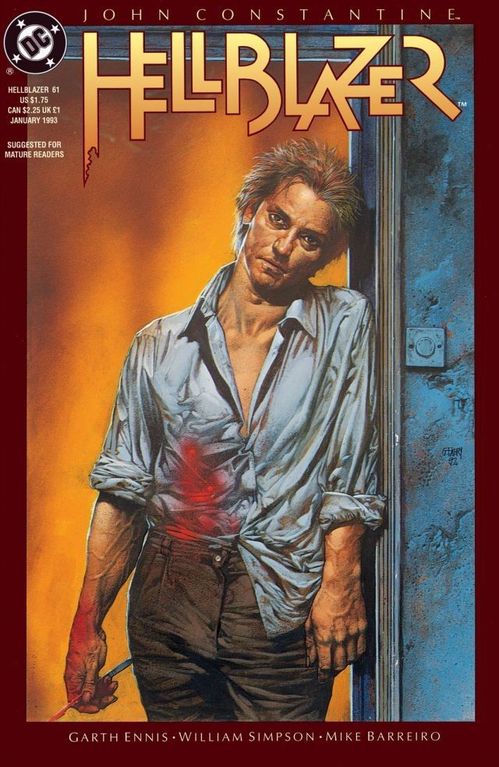
Hellblazer Cover Art by Glenn Fabry
4. Hellblazer
Artists: Steve Dillon, Others
Publisher: Vertigo/ DC Comics
British heroes aren’t gentlemen, and everyone knows it. Americans love their superheroes, and our capes bear the marks of our country: idealism, slogans, practical action and overweening force in the face of the slightest opposition. By contrast, British heroes are two hangovers away from being highwaymen. In the right light, every single popular British pulp hero of the last hundred years can be seen as a villain. Enter John Constantine, the working-man’s mage. A cigarette-addicted, trench-coat-wearing conman who rides the synchronicity highway. First summoned into existence by Alan Moore in the pages of Swamp Thing, Constantine was a popular protagonist from the get-go.
But Ennis took a page from Moore himself, and stamped the character with his own preferences. In other words, Ennis did with Hellblazer what he did with Punisher: took what already worked and made it better. He’s the BASF of comics, except without the war crimes.
Go on, pick your favorite Hellblazer run. The correct answer to that question, by the way, is “Dangerous Habits,” where Constantine has to talk his way out of lung cancer. But whatever your choice, whichever tale you prefer, there’s a good chance that Ennis was at hand for it, or that he sowed the seeds for it beforehand. Absolut Hellblazer. How much of Constantine’s tendency to spread misery and lies can be sourced to Ennis? The Moore version was an edgy know-it-all who walked on the wrong side of the law. Ennis’ Hellblazer was the too-clever self-destructive punk-rawk hero who drew in readers like iron shavings to the underworld’s magnet. With Moore’s Constantine, you couldn’t imagine what a man like that might do. With Ennis, you had the illusion that you knew where Constantine headed on a Saturday night: tying one off, down at the pub. The arch-bastard, a nasty piece of work, squire. Constantine was a man you didn’t like, but you couldn’t do without. That’s Ennis’ work—and he’s a more powerful magician by far thanks to it.
![]()
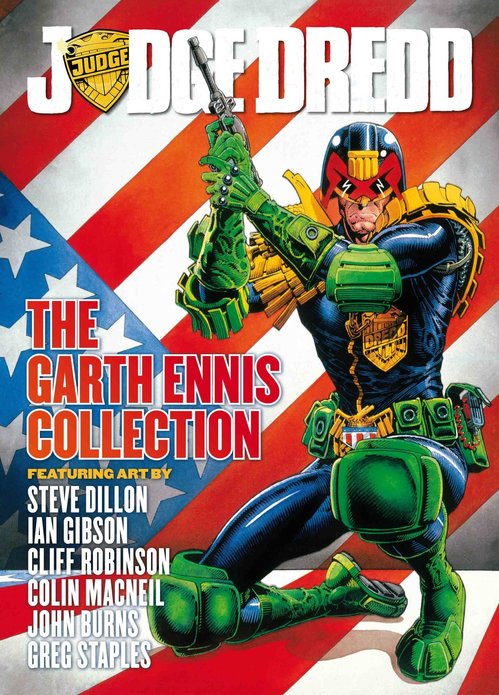
Judge Dredd Cover Art by Brian Bolland
3. Judge Dredd
Artists: Steve Dillon, Ian Gibson, Others
Publisher: 2000 AD
Pure, uncut Ennis, of the kind they don’t legally allow in most municipalities. Ennis’ Dredd is absolutely insane, and how I prefer my Ennis. This volume also features one the first pairing of one of the greatest partnerships in Western comics history: Dredd is where Ennis and the late, great Steve Dillon met. Not since Lee and Stonewall Jackson paired up have two men ridden together to commit such sins of appalling moral turpitude. But enough history. You might quibble with me putting Ennis’ Dredd work near the top of the list. The stories are short—no gigantic arcs, no long warbles on drinking pints with your mates at the pub. And there’s truth to that. But there’s also a scene where Dredd hands a guy a potato with an eye embedded in it. Put it another way: Dredd is where Ennis became Ennis. Everything we think of as Garth Ennis is learned at the feet of Dredd.
Judge Dredd came to life in British comics magazines as the merciless avatar of man’s law, and dark satire of How We Live Now. It’s grotesque, morbid and splendid. As the kids say on the Internets, “It me.” Or in this case, “It Ennis.” Under Garth Ennis, The Judge was given new life—and took on a huge, distorted aspect as an avenger of Everything Which Is Wrong.
There’s a scene in the Ennis stories where a bunch of mutated singing whales are headshot and turned into fish food. Tell me there’s a more Ennis panel than that. I’ve never been able to credibly separate where Mega City One ends and Garth Ennis begins. No wonder he took to it like a simile takes to a review sentence. Enjoy his visit to Murphyville and the Emerald Isle: ROAST POTATO LODGED IN THE FOREHEAD. GRUD!
![]()

Preacher Cover Art by Glenn Fabry
2. Preacher
Artist: Steve Dillon
Publisher: Vertigo/ DC Comics
Preacher is to Ennis as Watchmen is to Moore: if you’re reading this list, you’ve read the book, or at least had contact with it. So why bother telling you what you already know? This is the story of a cowboy, his assassin girlfriend and their Irish vampire pal as they search the Earth to find God. The story of Preacher is simultaneously as simple and as deep as a Steve Dillon face. Every great creator gets at least one of these, the work that is so big, so important, that it’s hard to speak about. Like discovering a word that means the entire world, a sound so large you can’t get it out of your mouth. Which is kind of the point of the book: a man who can utter the Word of God, but has trouble expressing himself.
I won’t say Preacher is a “mature” comic, whatever that word is supposed to mean. A more precise analysis is that Preacher is what early Image Comics promised and never delivered: hilarious depravity and artistic insight for comics-reading adults. Preacher makes a perfectly balanced pair with Sandman, the literary, somewhat uptight Vertigo title which is its opposite in so many ways. There’s a kind of wild invention and mad ambition at the heart of Preacher. Like The Simpsons or South Park, Preacher first became famous for its vulgarity, later for its evocative power.
Preacher was the best pairing of Ennis and Dillon. I can’t say that it’s Ennis at his height, even though it’s the book Ennis will be remembered for, the book that broke so many taboos and raised so many hackles. The travails of Jesse, Tulip and Cassidy could only have come from the decade that gave us Pulp Fiction, Natural Born Killers, The Doom Generation and a dozen other similar movies. Over 20 years later, Preacher’s still a hard-edged, merciless, shoot-em-up book with heartbreak, betrayal and easily 20 of the funniest comics panels ever put to paper. My friend Marcus and I used to yell, “CUHHH BE! CUHHH BE!” at each other during college.
Lots of people misread Preacher as a saga extolling tough-guy masculinity. If you’re one of these folks, a question: what is Jesse’s big emotional breakthrough near the end of the story? What happens to Cassidy, who’s the embodiment of Cool Rock Star Guy? What first changed the Saint, when he was a mortal man? What happens to traditional symbols of dudeness like Starr, The Allfather, Odin Quincannon and Jodie? Preacher is about leaving that behind. The series has aged, of course. No surprise there. The story is about growing up, and what we leave behind. Say it’s Ennis’ love letter to America, with everything that implies, and leave it at that. A hell of a vision.
![]()

Hitman Cover Art by John McCrea
1. Hitman
Artist: John McCrea
Publisher: DC Comics
Ennis can do superheroes. He doesn’t like it, but he can. This was his attempt, and he knocked it out of the park. Hitman is the story of a super-powered assassin named Tommy Monaghan who lives in the Cauldron, the poor Irish slum of Gotham. He’s telepathic and has X-ray vision, both of which cause him headaches if he uses them too often. After landing this half-assed power lottery, Tommy decides to specialize in killing superheroes with his buddy Nat.
In the grand pulsating vein of Ennis wish-fulfillment personal fiction-suits, Tommy stands pretty high up there as an author avatar. Especially the scene where Tommy has Batman at gunpoint and gets to say the words, “INFORM THE TROOPS, LORD VADER HAS ARRIVED.” Here’s what happened: Ennis and artist John McCrea saw a lot of John Woo films back in the ‘90s and wanted to make a comic. And what a splendid result.
Hitman is the gone-too-soon Ennis story: verily, the John Belushi of the Ennisverse. Other reasons this comic gets top billing, in no particular order: it’s literally the funniest thing Ennis ever wrote, including a shoot-out where Tommy and his friend hide behind a gigantic dead man at a burger joint; the best superhero team of all time, Section Eight; the most moving Superman story of the last 20 years (I’m surprised too); a rhyming Christmas story, where a man in a Santa suit tries to escape certain death by reciting the “Tears in the Rain” monologue from Blade Runner. Fam, there are scenes like this in every issue.
Let me return to Ennis and heroes, because it’s the key to why this book is godly. Ennis is working in a tradition which appalls him, using guest characters he hates, in a comic about a mafia hitman with superpowers. And it works. Honest to god, it does. He swims upstream, and it’s moving, hilarious, tragic, endlessly inventive and unique. You wouldn’t think a man in a green trench-coat in a bar of winos would be so distinctive, but it is. Hitman is also his most consistently good book, the tale where Ennis’ weaknesses are minimized: a perfect balance between Funny Garth and Irreverent Garth, Angry Garth and Moving Garth.
That’s why Hitman ranks above Preacher. Not because Preacher is a lesser work, but because Hitman is a better Ennis, an Ennis who had to work for it. One of Ennis’ heroes is Bill Hicks. It was said of Hicks that his best sets were when he had to play to annoyed or quiet crowds. Ennis operates according to the same principle. Think about it: Ennis goes into a field where spandex is the rule, and makes a career of it. He’s one of the greats, in a genre that he was born to rail against.
True, the man is always shouting at the audience, but what of it? Some writers will never tame. You come to Ennis for his dark humor, the abandonment of good taste, restraint and decency. You stick with him when he goes bleak and dramatic (as he always does). And in the end, you’re surprised by his heart. Every time. You big, lovable hired killer, you.
Jason Rhode judges a person by what’s in ‘em, not how they look. An’ he does the right thing, and he will try to be one of the good guys, son: ‘cause there’s way too many of the bad. He can be found on Twitter at @iamthemaster.